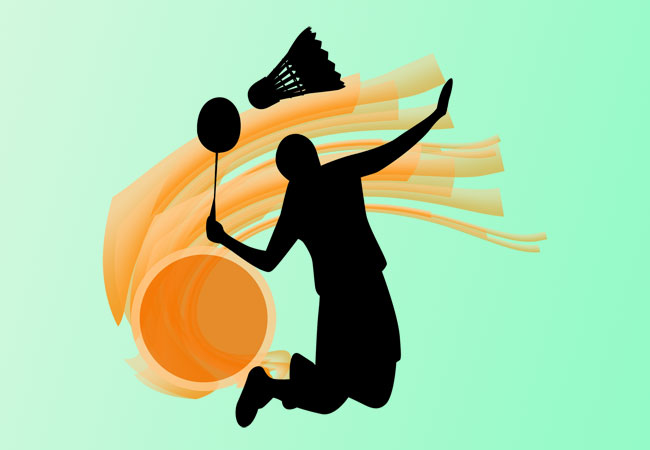I love nailing smashes past people. It feels good. Lots of players (especially the guys) put a lot of time into developing a great smash. Once you’re good at it, it feels good to practice it even more because it feeds your ego even if it doesn’t make many marginal improvements to your game overall.
However, the true benefit of a big smash isn’t the points you get from hitting those smashes past your opponent. It’s the fear that your smash instills in your opponent.
If you have a weapon in your game like a huge smash, or incredible netplay, your opponents will naturally fear that part of your game.

Master Multiple Skills To Scare Away Your Opponents
Now, if your smash is your only weapon, you’re in trouble, but if you can have a couple of other weapons, suddenly you’re a real threat. Your opponent is going to do whatever they can to stay away from that big smash of yours.
They will try and play to the net when it is probably not safe to do so, or they will try to keep the shuttle relatively flat to avoid giving you too much time to prepare for the big smash.
These behaviors give you some opportunities, and you need to develop your game to take advantage of them. Badminton isn’t about forcing winners. Rather it’s about setting up the rally to give yourself as many awesome opportunities as possible systematically. If you do this, you’re going to see results.
You should try and develop your weapons in pairs. Great net play goes well with a big jump smash. Strong flat play goes well with a killer half smash (or slice if you want to call it that).
Awesome defense goes great with good fitness (yes, I consider fitness a weapon of attrition). It would help if you were using one weapon to force them into another.
In the end, of course, a well-rounded game will prevail, but it doesn’t hurt to develop expertise in a few focused areas first.
Misused of Big Smash in Double
I observed that the big smash is often misused in a double play. Double players often think they can destroy the other team with these smashes, but in reality, usually, your opponents can return, and your partner is out of position.
Correct double play only uses a big smash just enough to back your opponents off the net so you and your partner can control the tempo of play. You are also correct when you say that you may win points if you have a big smash, but you probably won’t win the game.
The key for me is to identify your opponent’s weaknesses and play that particular match that way, so proficiency in all parts of the game is important to ensure victory.
The better you play, the tougher your opponents get. So, at a higher level, a big smash alone isn’t going to win you a point because your opponent’s defense is just as good. So I agree with emmet on following up your smash with another shot. You have to be prepared for a return even after a big smash, especially:
- Near the net- so it is essential to have a good net game.
- A weaker return somewhere in the mid-court, but away from you. Mostly cross-court. So it’s equally important for you to recover quickly from hitting such a powerful smash and again leap and intercept the weaker return to finish the rally eventually.
I do think pairing your weapons is very important. The key is to always use my weapon in my opponent’s weak spot to have the advantage.
Some players have good and powerful smashes, which makes their opponents fear them. But the problem is that they tend not to back it up when a cross-court defense comes, and most of them freeze and let it go.
But many of us hesitate to do it because it is physically draining after two/three times continuous smash when your opponent keeps on getting back the shuttle no matter where you smash or how powerful it is.
Powerful Smash Is Essential and Beneficial
No matter how the big powerful smash is quite beneficial. Yet, most of the time, we hesitate to do it as it is physically draining when you smash continuously for 4/5 times or more, especially when the opponent is as good as you.
I tend to play the deception shot over the head or drop, then finish the weak return with a smash. Initially, try some big smash, then your opponent will be conditioned to expect that big smash now and then, then you can mix it up and enjoy your game.
Initially, we have defined what a great smash is. I play with some friends whose smashes almost break the sound barrier, but as the shuttle travels almost parallel, the return is easy but often simple to kill.
However, if the smash is aimed at the body, head, or elbow and you can generate a weak return, you can easily kill the return with an acute angle smash, a sure winner. Therefore the true benefit of a great smash is that if properly targeted, it has the potential of forcing your opponents to make a weak return.
While a great smash helps, it is ultimately a combination of weapons ( footwork, netplay, smash, clears, defense, fitness, and knowledge of tactical play) and your temperament, which matters if you have to win consistently against good players.
Smashing is a quality that a badminton player needs regardless of gender. There are different smashes, such as sideline smash, body smash, overhead smash, backhand smash, and cross-court smash. If guidelines are given for every one of them, a player can become the world’s top player if they are well versed in the skill.
